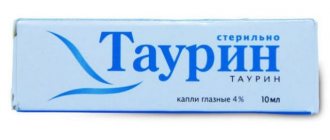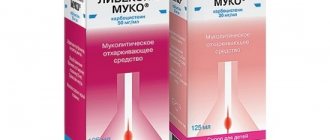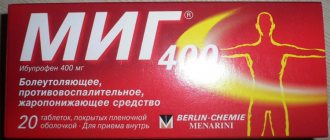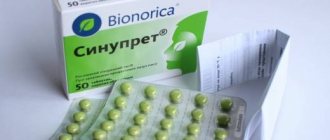Everything that Faspik Ibuprofen helps with can also be treated with regular Ibuprofen or Nurofen. Since Faspik is an analogue and generic of ibuprofen, that is, its main active ingredient does not differ from the main component of Nurofen, only the auxiliary components are different.
Medicines based on ibuprofen belong to non-steroidal anti-inflammatory drugs, and specifically to the group of drugs that are made on the basis of propionic acid.
What does Faspik consist of?
Faspik Ibuprofen is available in two forms - granules, which need to be dissolved in water, and tablets. One bag of granules contains 200 mg of ibuprofen, and one tablet contains 400 mg of the main component. The drug also contains excipients, such as:
- hypromellose;
- macrogol;
- sucrose;
- aspartame;
- sodium hydrocarbonate.
Also, to ensure that the solution from the granules has a pleasant taste and smell, various flavorings are added to it.
Ibuprofen in Faspika will play the role of the main active component; it is it that has an analgesic, anti-fever and anti-inflammatory effect.
Release form, composition and packaging
◊ Granules for preparing a solution for oral administration are white, with a characteristic mint odor; the prepared solution is colorless, opalescent, with a characteristic mint odor.
| 1 pack | |
| ibuprofen (as arginate) | 200 mg |
Excipients: arginine - 185 mg, sodium bicarbonate - 100 mg, sodium saccharinate - 15 mg, aspartame - 20 mg, mint flavor - 100 mg, sucrose - 2380 mg.
3 g - sachets (12) - cardboard packs. 3 g - sachets (30) - cardboard packs.
◊ Granules for preparing a solution for oral administration are white, with a characteristic mint-anise odor; the prepared solution is colorless, opalescent, with a characteristic mint-anise odor.
| 1 pack | |
| ibuprofen | 400 mg |
Excipients: arginine - 370 mg, sodium bicarbonate - 200 mg, sodium saccharinate - 20 mg, aspartame - 25 mg, mint flavor - 135 mg, anise flavor - 15 mg, sucrose - 1835 mg.
3 g - sachets (12) - cardboard packs. 3 g - sachets (30) - cardboard packs.
◊ Granules for preparing a solution for oral administration are white, with a characteristic apricot odor; the prepared solution is colorless, opalescent, with a characteristic apricot odor.
| 1 pack | |
| ibuprofen (as arginate) | 400 mg |
Excipients: arginine - 370 mg, sodium bicarbonate - 200 mg, sodium saccharinate - 20 mg, aspartame - 60 mg, apricot flavor - 180 mg, sucrose - 1770 mg.
3 g - sachets (12) - cardboard packs. 3 g - sachets (30) - cardboard packs.
Granules for preparing a solution for oral administration are white, with a characteristic mint-anise odor; the prepared solution is colorless, opalescent, with a characteristic mint-anise odor.
| 1 pack | |
| ibuprofen | 600 mg |
Excipients: arginine - 555 mg, sodium bicarbonate - 300 mg, sodium saccharinate - 25 mg, aspartame - 30 mg, mint flavor - 135 mg, anise flavor - 15 mg, sucrose - 1340 mg.
3 g - sachets (12) - cardboard packs. 3 g - sachets (30) - cardboard packs.
Granules for preparing a solution for oral administration are white, with a characteristic apricot odor; the prepared solution is colorless, opalescent, with a characteristic apricot odor.
| 1 pack | |
| ibuprofen | 600 mg |
Excipients: arginine - 555 mg, sodium bicarbonate - 300 mg, sodium saccharinate - 20 mg, aspartame - 60 mg, apricot flavor - 180 mg, sucrose - 1285 mg.
3 g - sachets (12) - cardboard packs. 3 g - sachets (30) - cardboard packs.
The description of the drug is based on the official instructions for use and approved by the manufacturer.
Indications for use
Faspik Ibuprofen is used in situations characterized by hyperthermia or moderate pain to alleviate the patient's condition. The instructions for use of Ibuprofen indicate the following diseases and pathological conditions for which this medication can help:
- Increase in temperature, regardless of the cause of fever;
- Toothache;
- Migraine;
- Neuralgia;
- Postoperative pain syndrome;
- Post-traumatic pain;
- Neuralgia;
- Unpleasant sensations during menstruation (algomenorrhea);
- Inflammatory joint lesions (arthritis, spondylitis).
Pharmacodynamics and pharmacokinetics
Pharmacodynamics
The drug belongs to the NSAID group. It has anti-inflammatory, analgesic (opioid type) and antipyretic effects. The mechanism of action is to disrupt the process of prostaglandin synthesis and blockade of COX-1 and COX-2.
The analgesic effect is most pronounced during the inflammatory process. The analgesic effect develops on average 30 minutes after taking the drug. Inhibits platelet aggregation. The drug relieves or significantly reduces pain, which is especially evident in joint pain, both at rest and during exercise, reduces swelling and morning stiffness, and increases the range of motion in the joints.
Pharmacokinetics
Faspik is well absorbed from the gastrointestinal tract, the Cmax of ibuprofen in the blood is achieved within half an hour. It binds well and quickly to blood proteins (about 99%), and is distributed in the synovial fluid and removed from it slowly. The drug is metabolized in the liver, the metabolites are inactive. Excreted in the urine (90% of the dose in the form of metabolites). The half-life is 1-2 hours.
Contraindications for use
Despite the fact that Faspik with Ibuprofen helps with fever and pain of various localizations, and is also a safe medicine, you should not take it without consulting a specialist, since there are a number of contraindications to its use:
- Individual intolerance to nurofen drugs, allergy to any of the components of the drug;
- Aspirin asthma;
- Blood diseases that lead to impaired blood clotting;
- Pathologies of optic nerve fibers.
also prohibited for children under 12 years of age and women carrying a child. In addition, it is highly undesirable to use ibuprofen during breastfeeding. If there are indications for taking non-steroidal anti-inflammatory drugs, it is better to ask your gynecologist to select analogues.
The drug 'Faspik' - instructions for use, description and reviews
From the gastrointestinal tract: NSAID gastropathy (abdominal pain, nausea, vomiting, heartburn, loss of appetite, diarrhea, flatulence, constipation; rarely - ulceration of the gastrointestinal mucosa, which in some cases is complicated by perforation and bleeding); irritation or dryness of the oral mucosa, pain in the mouth, ulceration of the gum mucosa, aphthous stomatitis, pancreatitis. From the hepatobiliary system: hepatitis.
From the respiratory system: shortness of breath, bronchospasm.
From the senses: hearing impairment (hearing loss, ringing or tinnitus).
From the central and peripheral nervous system: headache, dizziness, insomnia, anxiety, nervousness and irritability, psychomotor agitation, drowsiness, depression, confusion, hallucinations, rarely - aseptic meningitis (more often in patients with autoimmune diseases).
From the cardiovascular system: heart failure, tachycardia, increased blood pressure.
From the urinary system: acute renal failure, allergic nephritis, nephrotic syndrome (edema), polyuria, cystitis.
Allergic reactions: skin rash (usually erythematous or urticarial), skin itching, angioedema, anaphylactoid reactions, anaphylactic shock, bronchospasm or dyspnea, fever, erythema multiforme exudative (including Stevens-Johnson syndrome), toxic epidermal necrolysis (syndrome) Lyell), eosinophilia, allergic rhinitis.
From the hematopoietic organs: anemia (including hemolytic, aplastic), thrombocytopenia and thrombocytopenic purpura, agranulocytosis, leukopenia.
From the organs of vision: toxic damage to the optic nerve, blurred vision or double vision, scotoma, dryness and irritation of the eyes, swelling of the conjunctiva and eyelids (allergic origin).
The risk of developing ulcerations of the gastrointestinal mucosa, bleeding (gastrointestinal, gingival, uterine, hemorrhoidal), visual impairment (impaired color vision, scotoma, damage to the optic nerve) increases with long-term use of the drug in large doses.
Changes in laboratory parameters: bleeding time (may increase); serum glucose concentration (may decrease); creatinine clearance (may decrease); hematocrit or hemoglobin (may decrease); serum creatinine concentration (may increase); activity of “liver” transaminases (may increase).
Contraindications
- Inflammatory diseases with degenerative changes in the musculoskeletal system: osteochondrosis, arthritis of various etiologies, ankylosing spondylitis, neuralgic amyotrophy, gout.
- Pain syndrome: headache and toothache, arthralgia, myalgia, radiculitis, arthritis, migraine, in cancer, bursitis, tendency, neuralgia, tendovaginitis, post-traumatic pain syndrome with inflammation, adnexitis, algodismenorrhea.
- Feverish syndrome in infectious diseases.
- The drug does not affect the progression of the disease and is intended exclusively for symptomatic therapy at the time of use - reducing inflammation and pain.
Hypersensitivity to the drug, hemophilia, gastric ulcer, bleeding of various etiologies, lactation, pregnancy, optic nerve diseases, hypersensitivity to acetylsalicylic acid, age up to 12 years.
Use with caution in patients with arterial hypertension, liver cirrhosis, heart failure, renal failure, gastritis, colitis, enteritis, nephrotic syndrome, hyperbilirubinemia, and over the age of 60 years.
It is not recommended for women planning pregnancy in the near future.
Tablets at a dose of 400 mg orally, every 6 hours during meals, washed down with water. The maximum dose per day is 1200 mg. The duration of treatment should not exceed 7 days.
Granules - a packet is dissolved in 100 ml of water and taken with food or after meals. The dose for adults is one packet of 200 mg: 4 to 6 pieces per day; 400 mg - 3 pieces per day; 600 mg - 3 packets per day. The maximum dose per day when using 200/400 mg packages is 1200 mg and 2400 mg when using 600 mg packages.
For arthritis, to relieve morning stiffness, it is recommended to take the first dose immediately after waking up. The dose is reduced if the patient has heart, liver, or kidney diseases.
FASPIK (tablets): reviews
I first learned about the drug at my work in a pharmacy from medical representatives. I was inspired by the story and bought it for myself to try. They helped a lot with toothache, because in addition to pain relief, they have an anti-inflammatory effect. Like all NSAIDs, i.e. nonsteroidal anti-inflammatory drugs, they have analgesic, anti-inflammatory and antipyretic effects. But most of all I loved FASPIK in powders (in granules). There are 12 sachets in a package, the cost varies in different pharmacies. The last time I took it was in December for 96 rubles, it’s more expensive at my pharmacy. I call Faspik in powders: “miracle powder” - it turned out to be irreplaceable. The convenience is that you dilute it, preferably in warm water, so that it dissolves well, and if drinking warm is disgusting, then dilute it with a quarter glass of warm water, and then ...read more
add cold. Now there are two flavors: apricot and mint-anise. The first one came out mint-anise and it was disgusting to drink it warm, but because it helped so wonderfully, I endured it, drank it with my fingers over my nose - I can’t stand anise. It's good that they released an apricot flavor. Very often I take it instead of Coldrex, because the effectiveness is much higher. If it happens that my throat hurts in the evening, I immediately dilute Faspik and drink it warm, go to bed, and in the morning it’s as if nothing had happened, and most importantly, I didn’t get sick. If I'm sick, I drink it at night so I can sweat under the covers and recover faster. Mom, already old, often drinks when her legs hurt and twist, drinks at night and everything is fine. Once my mother had a toothache, but she didn’t have the opportunity to go to the doctor for some reason, and for a whole week she drank Faspic, the tooth didn’t go away, a week later she went and the doctor was surprised that she didn’t get swollen in a week, because .usually within a day the cheek is swollen from severe inflammation, bless you, but my mother survived safely on Faspika for a whole week. It also helps well with various swollen parts of the body (I’ll put it this way), i.e. neck, back of the head, back, etc. In general, in our family it goes great and for any pain-related problems we immediately turn to treasured powder. Therefore, I suggest everyone to try this drug. I would only note that people who have stomach problems (especially erosive-ulcerative ones) should be careful. All NSAIDs should not be taken on an empty stomach! This does not mean that the stomach should be full. I usually try to eat at least something before drinking Faspik, a couple of times when there is severe pain, and there was no time to eat, I drank it when I was hungry, but I have no problems with my stomach. I think those who suffer from some kind of illness will understand. Well, good luck and HEALTH to everyone!!!
I first learned about the drug at my work in a pharmacy from medical representatives. I was inspired by the story and bought it for myself to try. They helped a lot with toothache, because in addition to pain relief, they have an anti-inflammatory effect. Like all NSAIDs, i.e. nonsteroidal anti-inflammatory drugs, they have analgesic, anti-inflammatory and antipyretic effects. But most of all I loved FASPIK in powders (in granules). There are 12 sachets in a package, the cost varies in different pharmacies. The last time I took it was in December for 96 rubles, it’s more expensive at my pharmacy. I call Faspik in powders: “miracle powder” - it turned out to be irreplaceable. The convenience is that you dilute it, preferably in warm water, so that it dissolves well, and if drinking warm is disgusting, then dilute it with a quarter cup of warm water, and then add cold. Now there are two flavors: apricot and mint-anise. The first one came out mint-anise and it was disgusting to drink it warm, but because it helped so wonderfully, I endured it, drank it with my fingers over my nose - I can’t stand anise. It's good that they released an apricot flavor. Very often I take it instead of Coldrex, because the effectiveness is much higher. If it happens that my throat hurts in the evening, I immediately dilute Faspik and drink it warm, go to bed, and in the morning it’s as if nothing had happened, and most importantly, I didn’t get sick. If I'm sick, I drink it at night so I can sweat under the covers and recover faster. Mom, already old, often drinks when her legs hurt and twist, drinks at night and everything is fine. Once my mother had a toothache, but she didn’t have the opportunity to go to the doctor for some reason, and for a whole week she drank Faspic, the tooth didn’t go away, a week later she went and the doctor was surprised that she didn’t get swollen in a week, because .usually within a day the cheek is swollen from severe inflammation, bless you, but my mother survived safely on Faspika for a whole week. It also helps well with various swollen parts of the body (I’ll put it this way), i.e. neck, back of the head, back, etc. In general, in our family it goes great and for any pain-related problems we immediately turn to treasured powder. Therefore, I suggest everyone to try this drug. I would only note that people who have stomach problems (especially erosive-ulcerative ones) should be careful. All NSAIDs should not be taken on an empty stomach! This does not mean that the stomach should be full. I usually try to eat at least something before drinking Faspik, a couple of times when there is severe pain, and there was no time to eat, I drank it when I was hungry, but I have no problems with my stomach. I think those who suffer from some kind of illness will understand. Well, good luck and HEALTH to everyone!!!
Rating: 5 5
Source:
otzovik.com
Overdose
An overdose of the drug is accompanied by the following symptoms: nausea, abdominal pain, vomiting, drowsiness, depression, tinnitus, lethargy, headache, acute renal failure, metabolic acidosis, decreased blood pressure, tachycardia, bradycardia, atrial fibrillation, coma, respiratory arrest.
In cases of overdose, gastric lavage, alkaline drinking, activated charcoal, and forced diuresis are recommended within an hour after administration.







